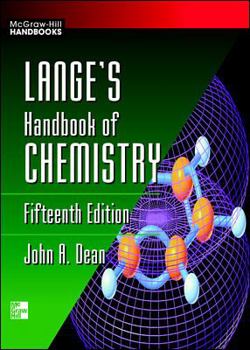Lange's Handbook of Chemistry
Select Format
Select Condition 
Book Overview
Publisher's Note: Products purchased from Third Party sellers are not guaranteed by the publisher for quality, authenticity, or access to any online entitlements included with the product.The Go-To... This description may be from another edition of this product.
Format:Hardcover
Language:English
ISBN:0070163847
ISBN13:9780070163843
Release Date:October 1998
Publisher:McGraw-Hill Professional Publishing
Length:24 Pages
Weight:5.50 lbs.
Dimensions:2.5" x 7.8" x 9.6"
Customer Reviews
1 rating
The handbook every chemist must have
Published by Thriftbooks.com User , 24 years ago
The NST/Engineers, Inc. reviewers have relied on the prior editions of this classic handbook for decades. We believe this 1999 fifteenth edition of Lange to be a close-at-hand, bookshelf necessity for science students, chemists, chemical engineers, and for others whose sphere of interest intersects with that of chemistry. Every industrial library and most general interest libraries should have a copy. For those unfamiliar with Lange, it serves as a first reference for questions dealing with "chemicals". Rather than chemicals we should refer to elements, molecular compounds, radicals, and mixtures of compounds, among other definitions of matter. (The properties of water, a molecular compound, are well covered in the book.) If you have been using a copy of the thirteenth edition, or earlier, you should upgrade now to this fifteenth edition. Division of the handbook contents into eleven major sections helps in searches. Lange Sections 1 and 3 are probably used most frequently to find densities, melting and boiling points, and solubilities in various solvents of organic and inorganic compounds. For the organic compounds, at the foot of the data page, alternate names are listed. Also there, structural formulas show details of the more complicated structures. For those who need in-depth information on any listed compound, the Beilstein reference is also given. There is an "Empirical Formula Index of Organic Compounds". Thus if you know the number of carbon, hydrogen, and other atoms in a compound's formula, you can readily find the properties of the one compound or a few specific compounds that match that formula. Section 2, "General Information, Conversion Tables, and Mathematics", is worthy of review by all who want to know where to find the recommended symbols, latest definitions, and SI (international or metric system) values for chemical and physical properties. For those of us still steeped in British and U.S. unit usage, there are conversion factors to and from just about any unit of interest. Section 4, "Properties of Atoms, Radicals, and Bonds", gives the electronic configuration and properties of the elements, bond lengths, radii, dissociation energies, a table of nuclides, and much more. Section 5 on "Physical Properties" goes into many other properties than the earlier organic and inorganic sections. Vapor pressure, viscosity, surface tension, and a host of other properties, are listed for the more widely used compounds and their solutions.Section 6, "Thermodynamic Properties", begins with an introductory explanation of enthalpy and entropy changes and heat capacity. Explanation of Gibbs energies is missing. However, all four of these properties are then listed for organic and inorganic compounds. Critical properties are also given. There are 138 pages of data together with some spectrometric property explanations in Section 7, "Spectroscopy".The 168 page Section 8, "Electrolytes, E




